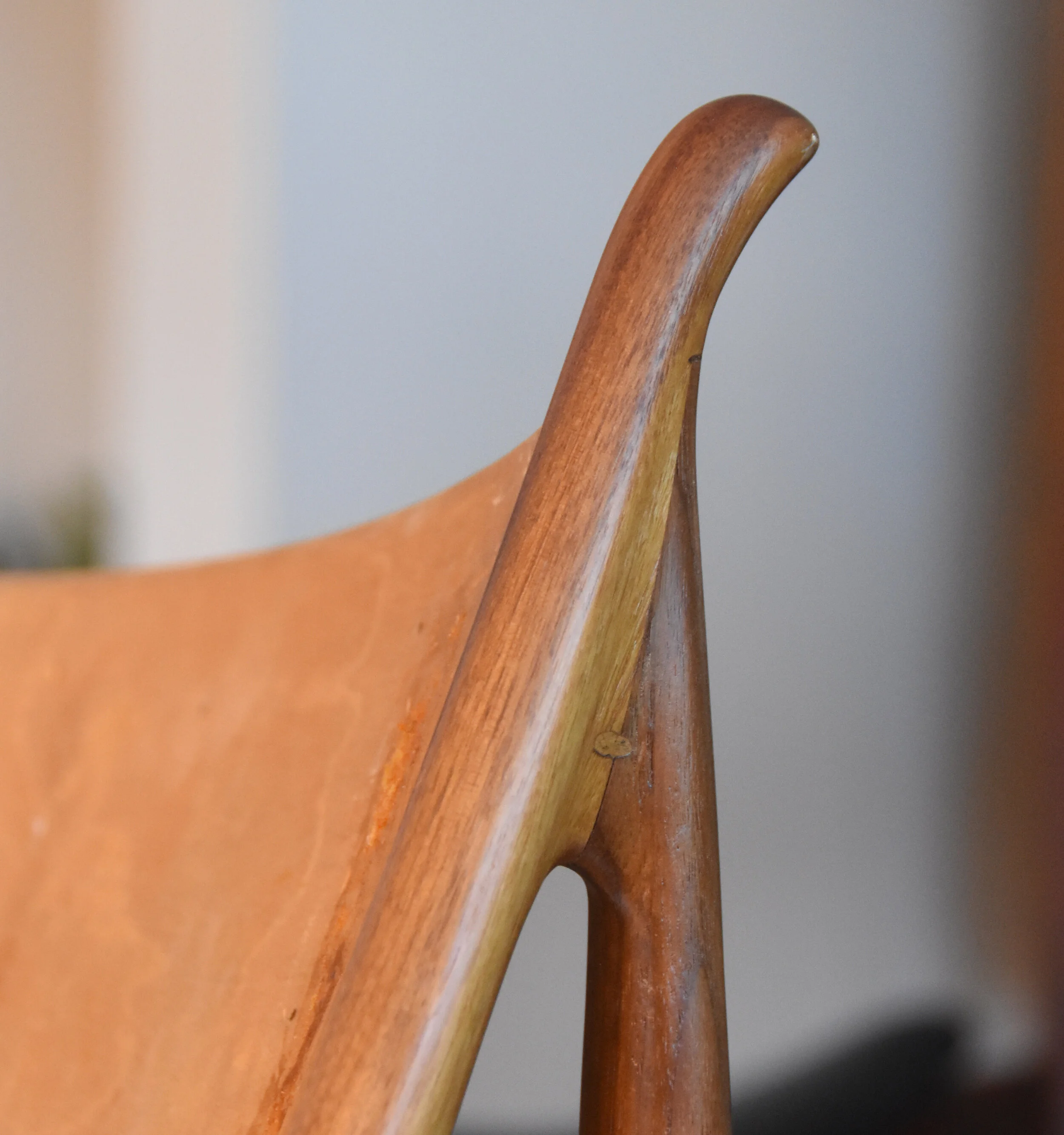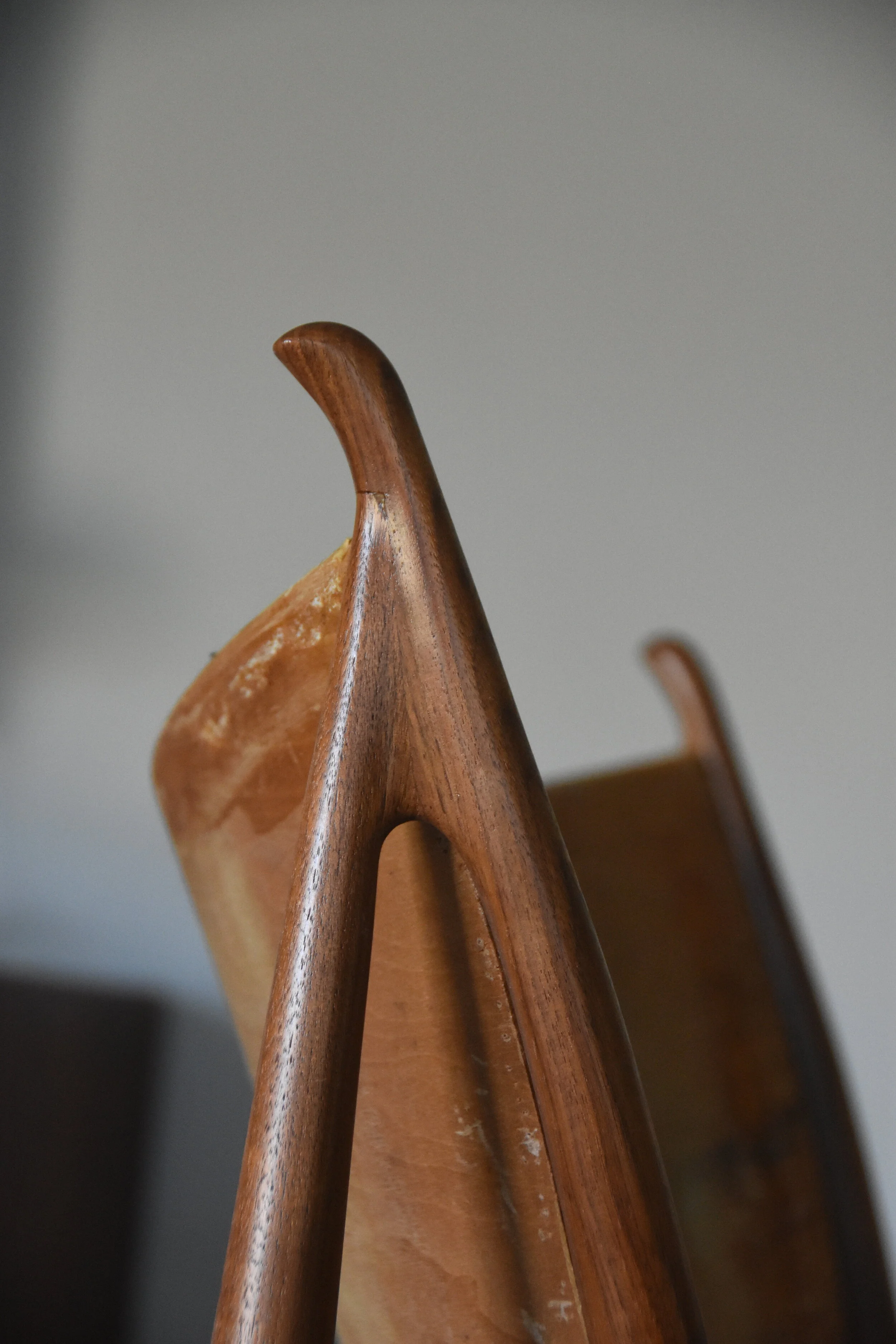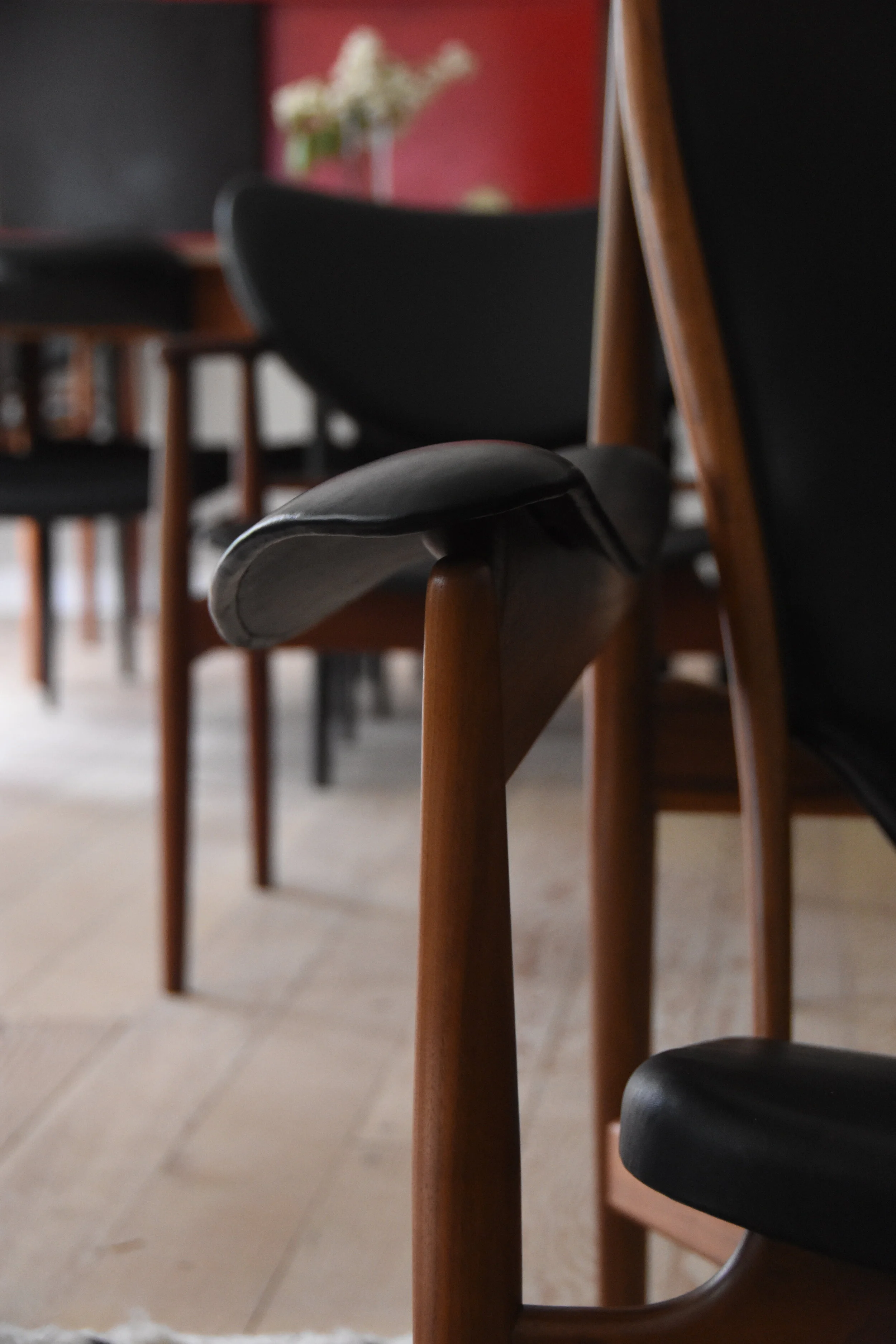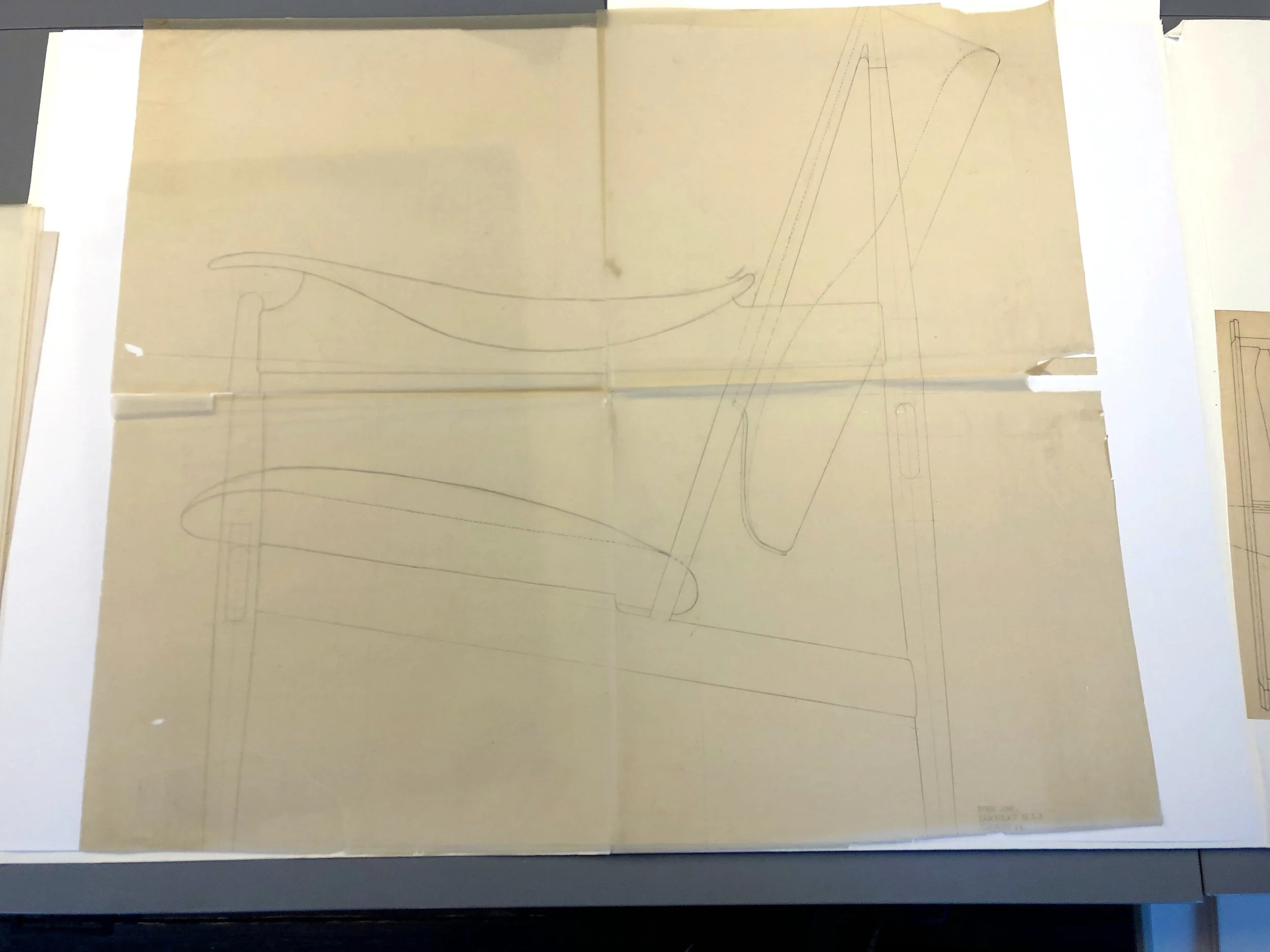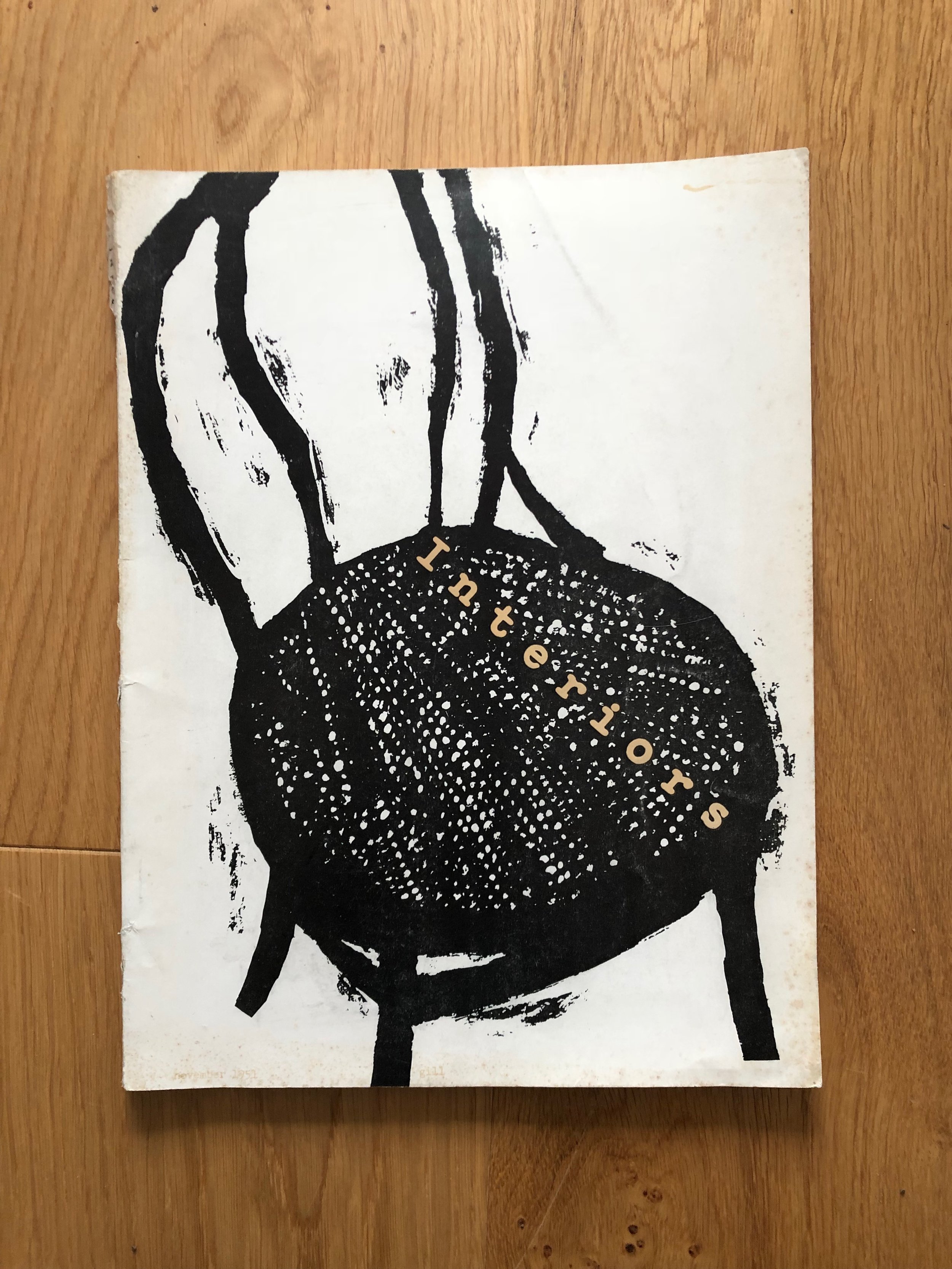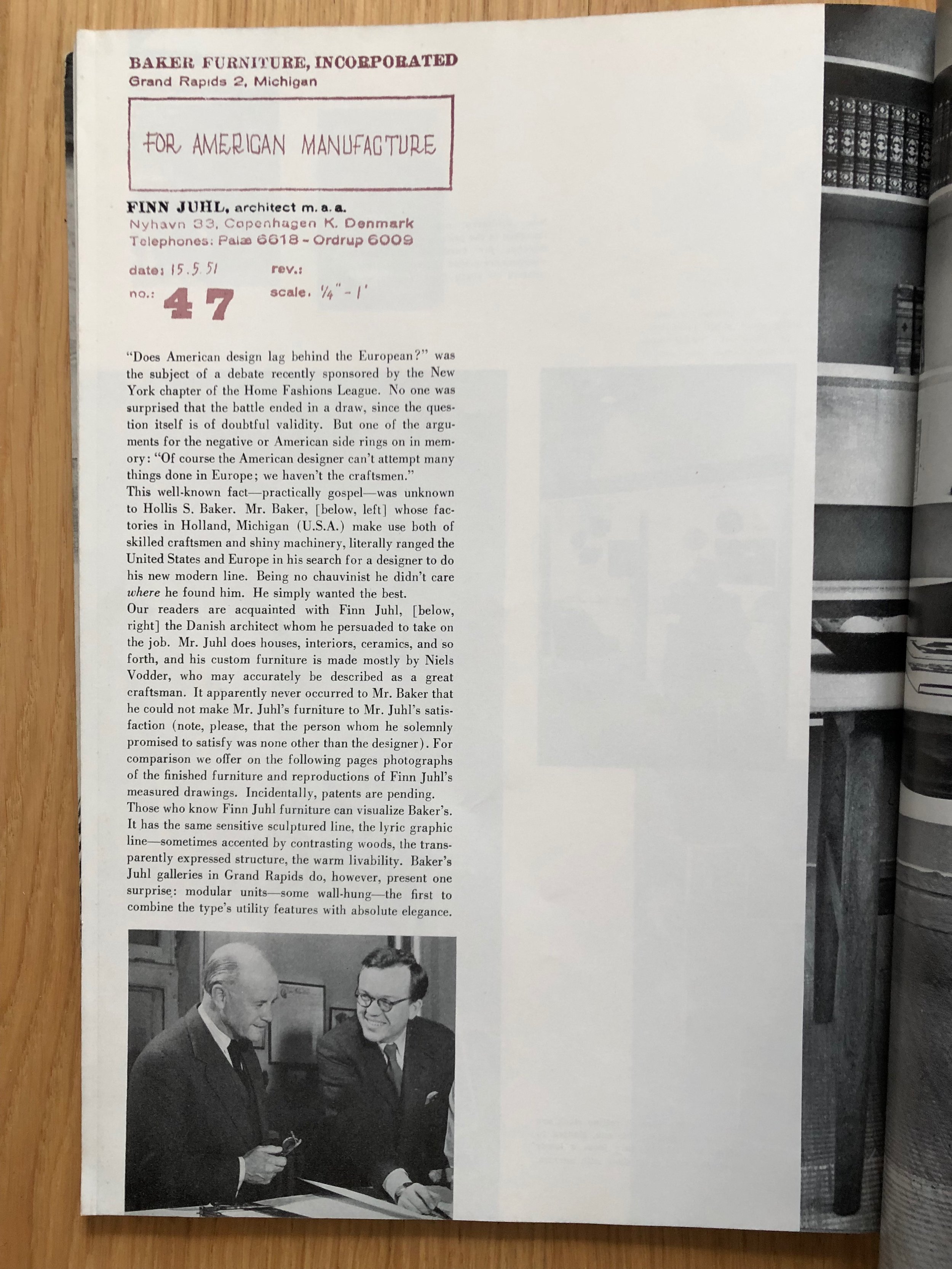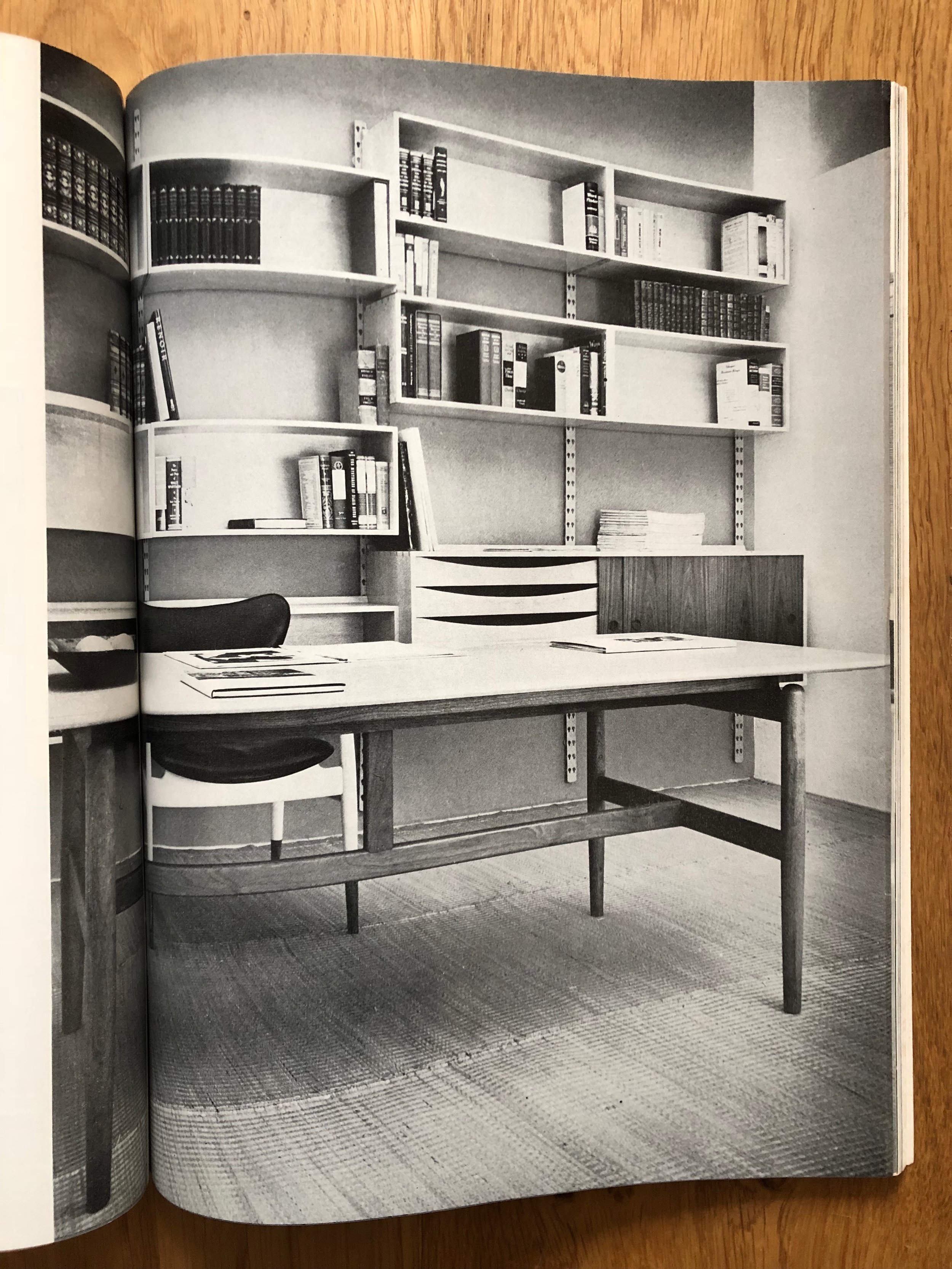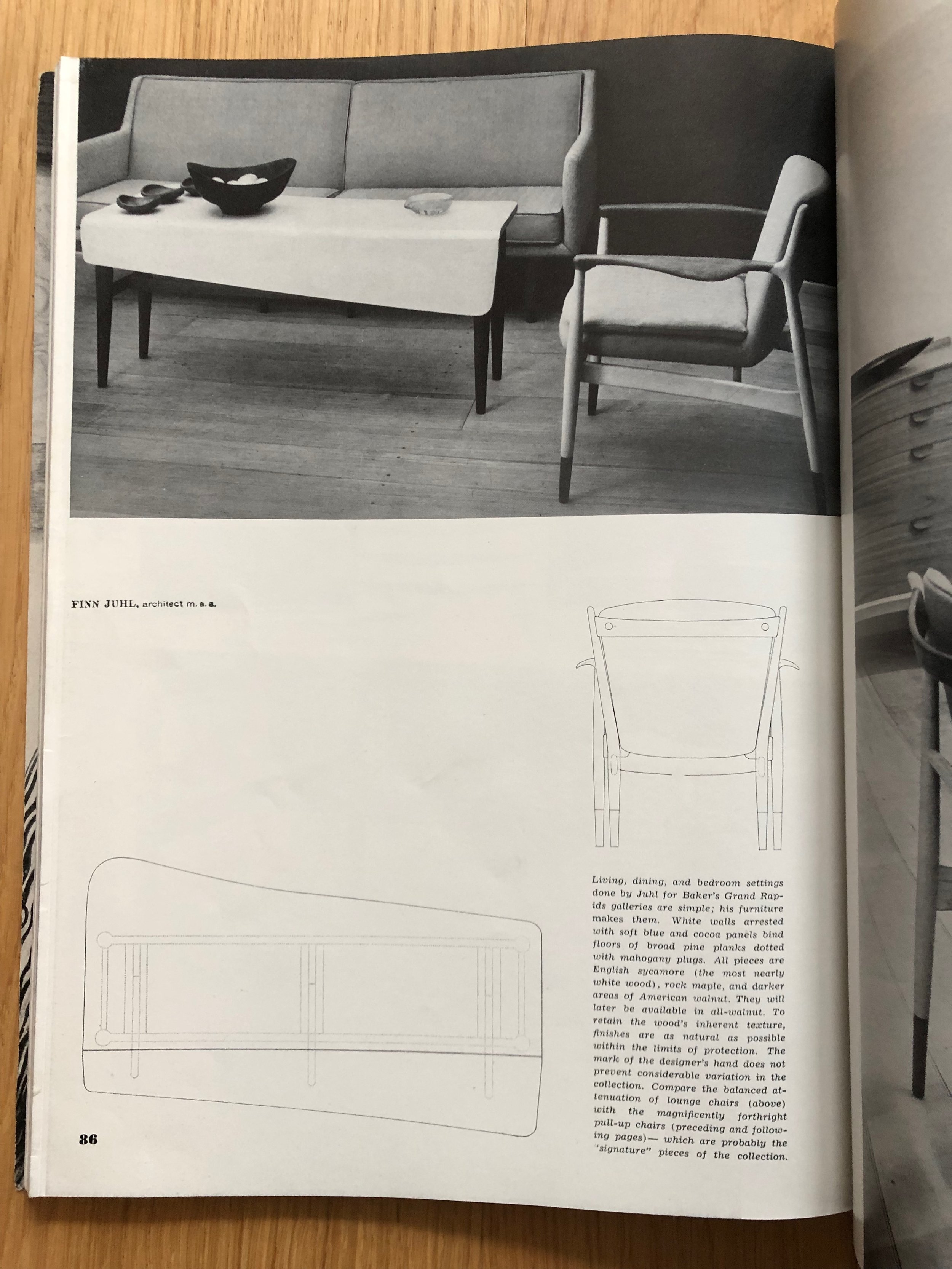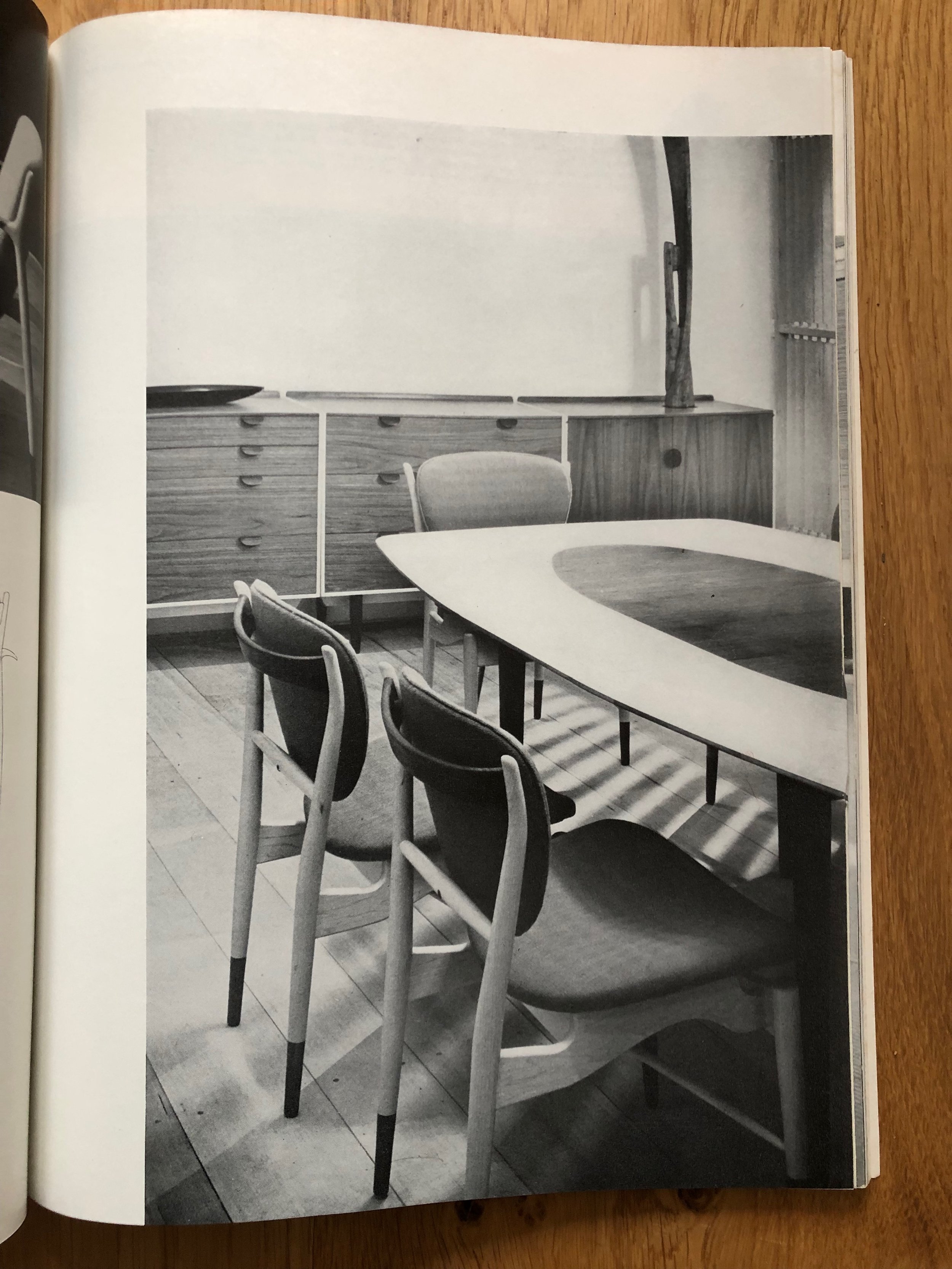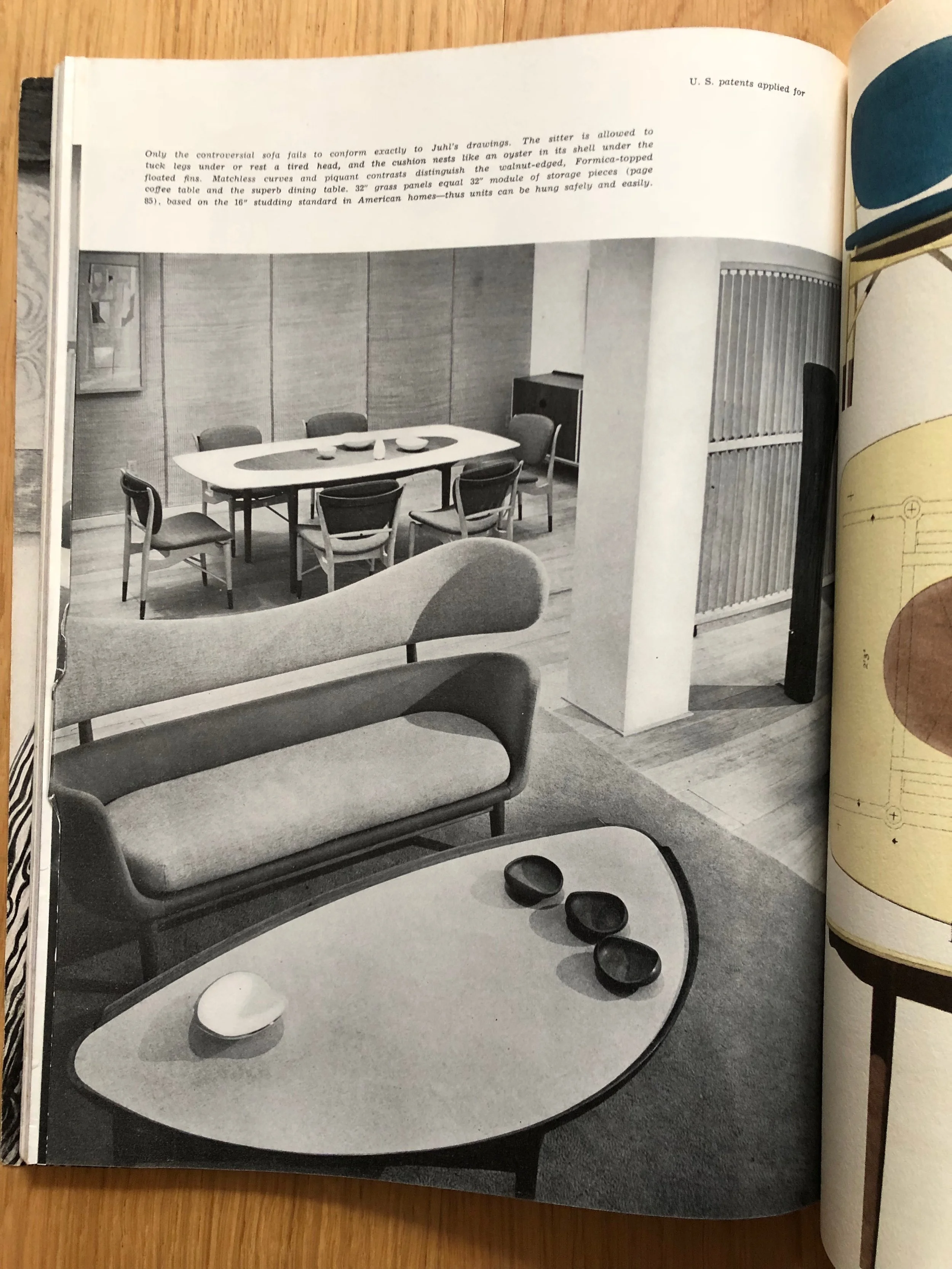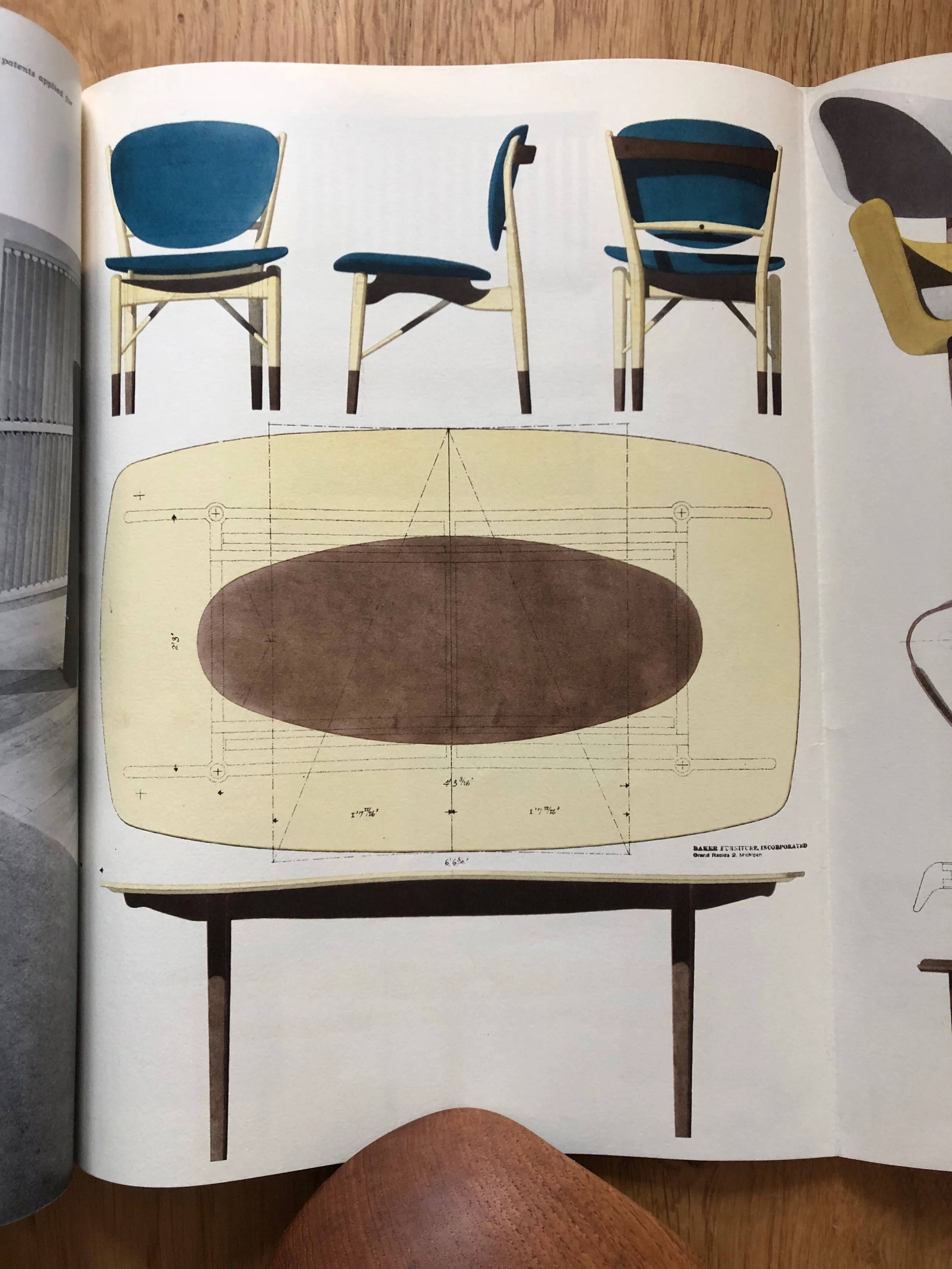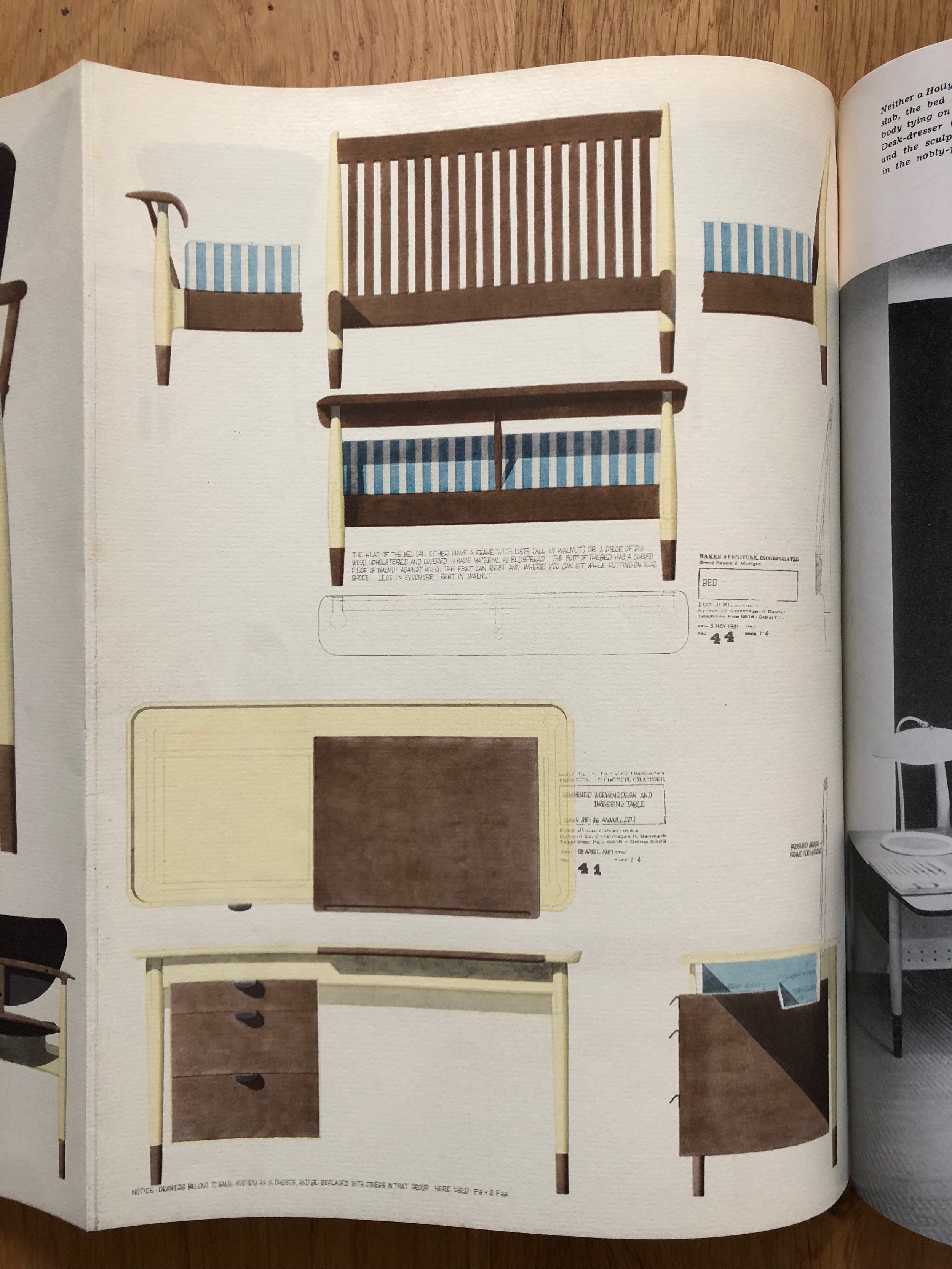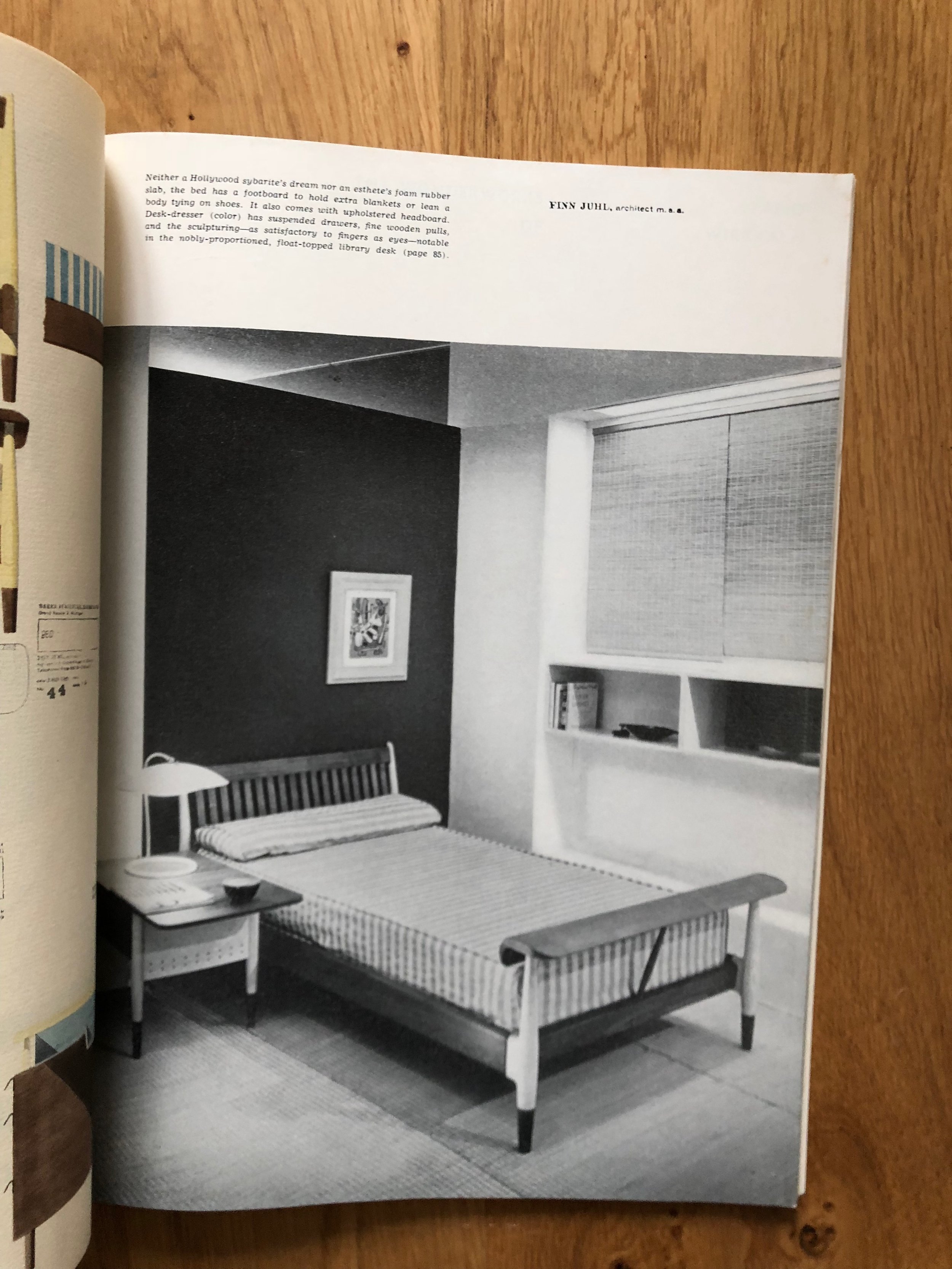Baker Furniture
Baker Furniture 1951-1957
In 1951, Finn Juhl signed a contract with Baker Furniture USA to make a selection of furniture for the American market. This was a relatively short lived cooperation which ceased in 1957 (approx).
We have recently had the good fortune to speak with Winsor White (93), former Vice President of Design at Baker Furniture from 1952–1963. Winsor worked directly with Finn Juhl and described visiting his office on Nyhavn in Copenhagen in 1954. He was able to provide some very valuable information that helps clarify aspects of the Baker Chieftain in the 1950s.
UPDATED: March, 2021
Recently we were very fortunate to finally have found a confirmed example of the 1950s Baker Chieftain chair. This chair was purchased at auction in the USA and was part of an estate that included several pieces of 1950s Baker produced Finn Juhl designs.
As we would expect from a Baker production, this chair is produced in solid American Walnut. It has been reupholstered, but thankfully we have photos of the chair stripped down completely, which reveals a number of very interesting aspects.
Like most Baker made furniture, the frame is stamped with the corresponding model number (440 1/2) which is seen in the Baker catalogue. The stamp is clearly seen when the seat is removed. We can also see that this chair has 5 seat tabs, which are the same hallmark machine-stamped stainless steel tabs seen on all of Baker/Finn Juhl chairs. Each tab contains 4 screws.
On the backside of the chair we can see the wooden spacer is sculpted but lacks the rubber bushing typically seen on earlier Niels Vodder made chairs.
The most notable and striking design difference between the Baker and Vodder production is the horn shape. The Baker chair shares the step joint detail with the Vodder chair, but the Baker chair’s horn is very elongated making it easy to identify. We can also see a small dowel in the left horn.
The metal armrests are cast aluminum, which is what would expect from Baker. We know most Vodder chairs are planished steel, with a few exceptions from the early 50s made of cast-steel. Unlike all Vodder chairs, the Baker chair threaded the arm plate blots through the top of the armrest.
It goes without saying, the discovery of this chair has answered a lot of questions about a very opaque period in the evolution of the Chieftain chair. We can surmise that the unlicensed version of the chair made by Interior Crafts Inc. was copied from Winsor White’s authentic Baker Chieftain chair when he sent it to Interior Crafts Inc. for reupholstery in the late 1980s (read more about Winsor below).
We also know that the Baker Chieftain chair was made in very few numbers, and it can be regarded as one of the rarest iterations of the Chieftain. It is very well made, with wonderful attention to detail, and craftsmanship. We don’t have any evidence that pinpoints the production dates for the chair. We know that Interiors Magazine ran an ad for the Chieftain chair in April 1954, however, the photo of the chair they used was not a Baker chair (it was the Niels Vodder produced chair that Baker bought and donated to the Interior52 Exhibition). More likely the chair was produced from 1955/56.
UPDATED: June, 2019
Winsor himself owned two Chieftain chairs acquired while working at Baker. One chair was a Niels Vodder version and the other was a Baker version. He confirmed that Baker did in fact make a very small number of Chieftain chairs at their Holland, Michigan location. This would have been towards the end of the Baker/Juhl cooperation (circa 1955).
The Niels Vodder chair that Winsor owned was sent to Baker directly from Niels Vodder so that Baker’s cabinetmaker could replicate the exact specifications of the Danish chair. The Baker chair that Winsor owned was the first prototype chair made by their cabinetmaker who followed the Niels Vodder Chieftain chair with exactitude. This is a very illuminating revelation, because we can infer that since they were copying directly from the Niels Vodder (not the 1950’s drawing), that the Baker horn joinery looked exactly like Vodder’s step joint. Winsor also said that in the 1950s Baker handcrafted all the furniture that they made, and it is a misconception to think that they were an assembly line factory. In the case of the Chieftain chair, they were made individually by hand – and likely that one cabinetmaker would make the chair frame from beginning to end.
Although Finn Juhl’s original 1950s Baker Chieftain drawing in the archives of the Design Museum in Copenhagen (see below) shows the chair with a capped horn, we now know thanks to Winsor’s latest remarks that Baker copied the Niels Vodder chair directly. He also recalls that the Baker Chieftains were all upholstered in and natural coloured leather. He also said that the chairs were made with cast aluminum arms, not molded plywood like the 1990s Baker Chieftain.
Winsor was also able to shed some valuable insight on the reason why the Baker / Finn Juhl cooperation ended. Towards the mid-1950s, Hollis Baker was easing back on his roll in operations, and Frank Van Steenberg, VP of Baker Furniture was basically running the company. Frank disliked modern furniture, and when a Finn Juhl design was not selling well, Frank would simply terminate that design's production. One at a time, the line diminished until eventually there was nothing left. Thus, there was no firm termination date, rather it was a slow dissolution of the Finn Juhl Collection.
Special thanks to Winsor White, Melissa White and Maybelline Te for your invaluable assistance.
Photo: Winsor White, 1958. Winsor was the VP of Design at Baker Furniture from 1952–1963.
The 1950s Drawing
Finn Juhl did draw a concept for a Baker Chieftain chair which we found in the archives of the Danish Design Museum, in Copenhagen along with a number of other original Baker drawings. Although the Chieftain drawing is not dated, Juhl writes the ‘Nyhavn 33’ office address in the corner of the drawing, which means the drawing dates between 1951–1956. (Juhl’s office moved to Sølvgade in 1957).
Photo: Finn Juhl’s original drawing of the Baker Chieftain chair drawn sometime between 1951-56
Photo courtesy of the Danish Design Museum, Copenhagen
Photo: Finn Juhl signed the Baker drawing with his Nyhavn 33 office address, which he was in until 1956.
Photo courtesy of the Danish Design Museum, Copenhagen
Finn Juhl’s drawing of the Baker Chieftain chair has one significant difference when compared to the Niels Vodder version – a distinct ‘capped’ horn detail (circled in pink below). Winsor White described the capped horn as a way to make the chair more suitable for Baker’s factory production. You can see that the capped horn was used in the 1990s Baker Chieftain chair (see below).
Photo: (Left) 1950s Drawing of Baker Chieftain chair shows Finn Juhl intended for the chair to have a capped horn joint. (Right) 1990s Baker chair employed this capped horn detail. Photo courtesy of the Danish Design Museum, Copenhagen
The Baker 1951 Showroom
When we study Finn Juhl’s drawings of the 1951 Baker showroom, we can see that the Chieftain chair is nowhere to be seen. It seems a strange considering it was his most famous and celebrated design that brought him into the international spotlight in 1950. Whatever the case, it was not included in the original Baker offering in 1951.
Photo: Finn Juhl’s drawing of the Baker showroom in 1951. Photo courtesy of the Danish Design Museum
Interiors Magazine Exposé
Interiors magazine did a feature article on Finn Juhl’s cooperation with Baker furniture. The exposé features photos of Juhl and Hollis Baker, as well as a colour gatefold of Juhl’s water colours intended to be produced by Baker at that time. There is no mention of the Chieftain chair.
Photos: Interiors Magazine, November 1951
Baker and Interior 52
On a recent visit to Nordenfjeldske Kunstindustrimuseum (NKM) in Trondheim, Norway, we made some important discoveries.
In 1952, NKM commissioned Finn Juhl to design a room at the museum which was part of a larger exhibition called, Interior 52. We were fortunate to have access to the museum’s archives, which contained several original letters from Finn Juhl, Niels Vodder and Baker Furniture, which specifically discuss the Chieftain Chair. In these letters we learn that Baker Furniture generously donated a Baker made worktable, and 48 desk chair to the exhibition. Surprisingly we also learn that Baker also donated a Chieftain chair to the exhibit – however they paid Niels Vodder to make the chair for them. This is confirmation that at the end of 1952, Baker was still not making the Chieftain Chair.
Photo: A letter from Baker Furniture’s Vice President, Frank Van Steenberg describing the furniture they are donating to the Interior 52 exhibition at the Nordenfjeldske Kunstindustrimuseum (NKM), in Trondheim, Norway. Photo courtesy of the Nordenfjeldske Kunstindustrimuseum
There are also two letters written by Niels Vodder in which he describes making and shipping the chair to the museum after the chair was presented to the 1952 Guild Exhibit. The second letter addresses how the Chieftain Chair was damaged in shipping, and Vodder discusses how the museum should handle repairing the chair in time for the opening of the exhibit. He also describes that the chair is made of Imbulia wood (Brazilian Walnut), which is similar to Brazilian rosewood.
Photo: Letter from Finn Juhl to the director of Nordenfjeldske Kunstindustrimuseum outlining the items being used in the Interior 52 exhibition. He clear says that Baker is sending a desk and desk chair, and the rest will come from Niels Vodder. Photo courtesy of Nordenfjeldske Kunstindustrimuseum
Photo: Letter from Niels Vodder to the museum director discussing the Chieftain Chair he has made for the Interior 52 exhibition. Photo courtesy of Nordenfjeldske Kunstindustrimuseum
Photo: Continued correspondence about the damage to the chair during transport. Photo courtesy of Nordenfjeldske Kunstindustrimuseum
Photo: Inventory cataloguing from the Nordenfjeldske Kunstindustrimuseum of the Interior 52 Chieftain chair. Letter clearly states that the chair was gifted to the museum from Baker Furniture. Also discusses that the chair is made of imbuia wood. Photo courtesy of Nordenfjeldske Kunstindustrimuseum
The Baker Catalogue
In Baker’s final catalogue (circa 1954), the Chieftain chair finally makes an appearance. There is also a hi-res version of this image from an April 1954, Interiors magazine. In this photo we can see that the chair does not have the capped horn detail that Finn Juhl drew for the Baker Chieftain Chair in the 1950s. In addition to the Finn Juhl drawing, Winsor White (Baker, VP of Design) describes the chair being produced with capped horns. So we need to ask ourselves, where does the chair in this photo came from?
Photo: High resolution image of the chair that appears in Baker’s final Finn Juhl catalogue. Notice the highly figured wood.
Photo: Baker ran a short series of ads using this photo in 1954. Notice the stained and dirty leather.
Photo: Finn Juhl & Niels Vodder catalogue, 1956.
Photo: Comparing the image from the Baker catalogue (left) to the image of the chair from Niels Vodder’s catalogue (middle), we can see that the two chairs have an identical composition. When the chairs are layered with 50% opacity (right), there is little doubt the Baker catalogue chair looks exactly like a Niels Vodder production.
The 1952 Guild Exhibition Chair
The Baker photo (right) appears to have a distinct looking grain along the front stretcher, and the vertical stile piece. The figurial characteristics of the wood look remarkably like rosewood (or imbuia). Interestingly, we can see that the Guild Exhibition Chair in 1952 (left) has the same grain pattern. Specific emphasis on the front stretcher contrasts.
Photo: The earliest known photo of the Interior 52 chair at the 1952 Cabinetmakers Guild Exhibition (left) and the Baker catalogue photo (right).
The chair from the Cabinetmakers Guild Exhibition is the same chair from the NKM Museum. The museum still has the original 1952 Chieftain Chair in their collection, and we can see from recent photos how it compares to the Baker catalogue photo. Clearly, decades of sitting in front of a window has faded the NKM chair, but there is no mistaking the grain of the two chairs match.
Photo: Interior 52 chair today (left) and Baker catalogue chair (right). The grains match.
So, this shows us that it is extremely likely that the Baker photo is of the Niels Vodder chair from the Interior 52 Exhibit. We know Baker paid Niels Vodder to make this chair, and presumably they felt that they were entitled to use it in their 1954 ads despite the dirty leather.
The Baker Chieftain – 1998
Baker also made a Chieftain Chair in 1998 when they decided to reintroduce Finn Juhl’s furniture line. In a recent conversation with John Black, former Vice President of Design at Baker Furniture in the 1990s, he discussed the launch of the Chieftain Chair. The chair was designed in adherence to the original Finn Juhl 1950s chair (with exception of the molded plywood arms). As we can clearly see, the 1990s Baker Chieftain Chair has the capped horn feature, which the 1950s chair also had. Unfortunately, the 1990s chair did not sell well, and was discontinued after a short time. John also recalls at the time of the launch that the 1990s Chieftain Chair it was presented alongside an authentic 1950s Chieftain Chair.
Photo: Promotion picture of the 1998 Baker Chieftain chair
Photo: Tacks on the underside of the Baker chair confirms the arm shells were originally made of plywood.
Photo: Pristine example of an all–original 1990s Baker Chieftain chair.







